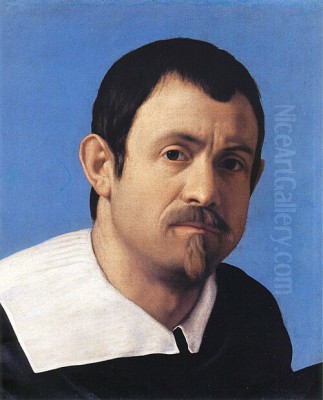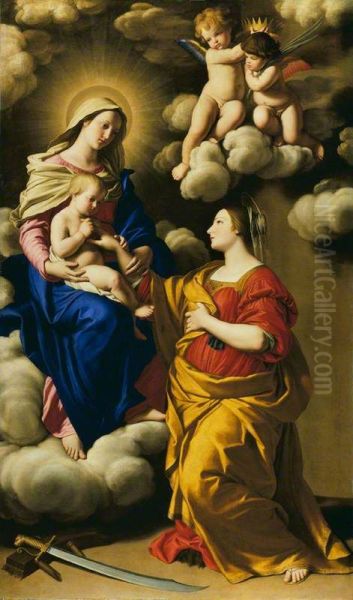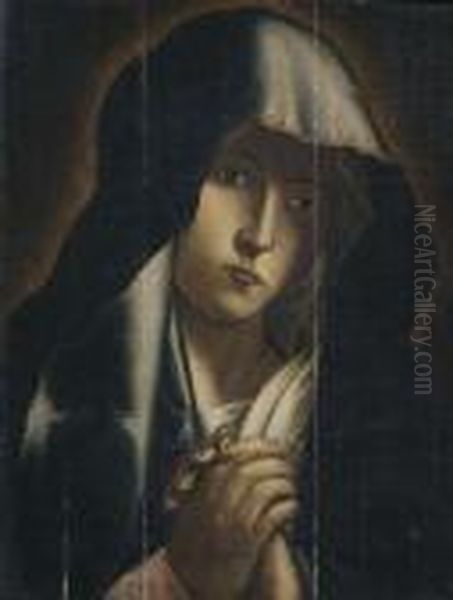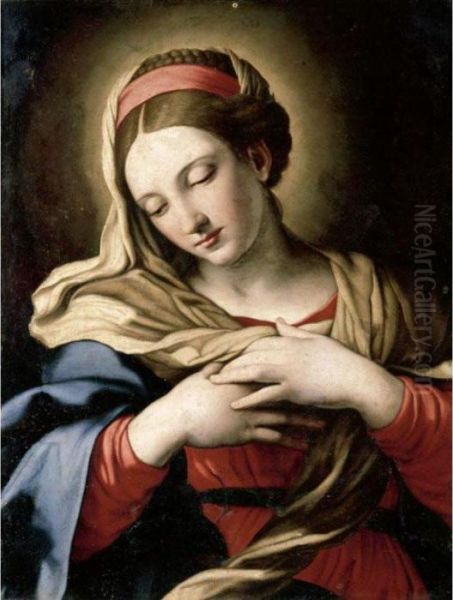
Giovanni Battista Salvi, more famously known by the name of his birthplace, Sassoferrato, stands as a unique figure within the vibrant tapestry of Italian Baroque art. Born on August 25, 1609, in the small town of Sassoferrato in the Marche region of Italy, and passing away in Rome on August 8, 1685, his artistic journey unfolded primarily in the bustling art centers of Italy, particularly Rome. While living and working during the height of the Baroque era, Sassoferrato's style consciously looked back to the masters of the High Renaissance, creating a distinctive blend of classical grace and devotional intensity that earned him lasting recognition, albeit one that waxed and waned over the centuries.
The Artist Known as Sassoferrato
It was common practice during the Renaissance and Baroque periods for artists to become known by a name associated with their place of origin or a notable characteristic. Giovanni Battista Salvi is almost exclusively referred to in art history as "Sassoferrato." This moniker, derived directly from the town where he was born, has become synonymous with his specific artistic identity. Using his toponym distinguishes him immediately and points to his roots outside the major artistic hubs like Rome, Florence, or Venice, even though he spent a significant portion of his productive life in Rome. This naming convention helps situate him within the broader landscape of Italian art history.
Early Life and Artistic Formation
Details about Sassoferrato's earliest life and training begin with his father, Tarquinio Salvi. The elder Salvi was also a painter, though his works are less known and primarily survive in their hometown. It was under his father's guidance that Giovanni Battista received his initial instruction in the fundamentals of drawing and painting. This familial introduction to the craft provided a foundation upon which his later, more formal training would build. Surviving works by Tarquinio suggest a competent, though perhaps provincial, style, which the son would soon transcend.

Seeking broader horizons and more advanced instruction, the young Sassoferrato eventually made his way to Rome, the undisputed center of the art world in the 17th century. Sources also suggest time spent in Naples. A pivotal moment in his development was his association with the Bolognese painter Domenichino (Domenico Zampieri). Domenichino was himself a leading figure in the classical tradition that emerged from the Carracci Academy in Bologna and was highly active in Rome. Studying with or being significantly influenced by Domenichino placed Sassoferrato firmly within the lineage of Bolognese classicism.
This connection brought him into the orbit of the Carracci school's ideals, emphasizing drawing, clarity, and a return to Renaissance principles as a corrective to the perceived excesses of Mannerism. The Carracci – Annibale Carracci, Agostino Carracci, and their cousin Ludovico Carracci – had revolutionized Italian painting at the end of the 16th century, advocating for a synthesis of High Renaissance grace (particularly Raphael and Correggio) with Venetian color and naturalism. Domenichino was one of Annibale's most important pupils, known for his measured compositions, idealized figures, and expressive clarity. Sassoferrato absorbed these classical tenets.
Dominant Influences: Echoes of the Renaissance
While Domenichino and the Carracci circle provided a contemporary classical framework, Sassoferrato's deepest artistic affinities lay with the masters of the High Renaissance, particularly Raphael (Raffaello Sanzio da Urbino). His reverence for Raphael was profound and became the defining characteristic of his art. He studied Raphael's compositions, figure types, and serene moods intently, often creating direct copies or variations on Raphaelesque themes. This dedication led some later critics to view him merely as an imitator, but it was a conscious choice rooted in a belief in the enduring perfection of Raphael's style.
Beyond Raphael, the influence of Perugino (Pietro Vannucci), Raphael's own master, is also evident. Perugino's sweet, pious figures and clear, harmonious compositions, typical of the Umbrian school of the late 15th century, resonate in Sassoferrato's gentle Madonnas and saints. The quiet devotion and delicate sentiment found in Perugino's work find a clear echo in Sassoferrato's paintings, contributing to their characteristic tenderness and approachability.
Elements of Titian's (Tiziano Vecellio) work, particularly his rich use of color and perhaps the modeling of figures, may also have played a role, though filtered through the lens of Roman and Bolognese classicism. Sassoferrato’s palette, while often favoring pure, bright hues like ultramarine blue and deep reds, sometimes shows a Venetian sensitivity to color harmony. However, his primary allegiance remained with the central Italian tradition of disegno (drawing and design) championed by Raphael and the Florentine/Roman schools.

Other contemporary or near-contemporary artists whose classicizing tendencies might have resonated with Sassoferrato include Guido Reni and Francesco Albani, both key figures from the Bolognese school who enjoyed immense success in Rome. Reni's idealized figures and graceful compositions, and Albani's charming mythological and religious scenes, shared a commitment to beauty and clarity that aligns with Sassoferrato's own aesthetic. There is also speculation about the influence of the French painter Pierre Mignard, who worked in Rome during the 1630s-1650s and also practiced a classicizing style.
Artistic Style: Baroque Classicism with an Archaic Touch
Sassoferrato's style is best described as a form of Baroque Classicism, yet it possesses a distinct quality often termed "archaizing." While working within the Baroque period, he deliberately eschewed the dynamism, dramatic intensity, and complex allegories favored by many contemporaries like Pietro da Cortona or Gian Lorenzo Bernini. Instead, he favored stillness, clarity, and emotional restraint, characteristics more aligned with the art of a century earlier.
His technique was meticulous. He applied paint smoothly, often leaving little trace of brushwork, achieving an enamel-like finish. This high degree of finish contributes to the precious, object-like quality of many of his smaller devotional works. His drawing is precise and elegant, defining forms with clear outlines. Colors are typically pure and luminous, with a particular fondness for rich blues (often ultramarine derived from lapis lazuli, a costly pigment) for the Virgin Mary's mantle, set against deep reds and luminous whites.
Light in Sassoferrato's paintings is usually clear and even, gently modeling forms rather than creating the dramatic chiaroscuro associated with Caravaggio or his followers (the Caravaggisti). The overall mood is one of serene piety, sweetness, and intimacy. His figures, especially his Madonnas, possess an idealized, almost porcelain beauty, characterized by oval faces, downcast eyes, and gentle expressions. This focus on devotional sweetness made his works highly sought after for private prayer and contemplation.
Signature Themes: The Madonna and Devotional Imagery
Sassoferrato specialized, almost to the point of exclusivity, in religious subjects. His most frequent and famous theme was the Madonna, depicted either alone in prayer or contemplation, or with the Christ Child. He produced numerous variations on these themes, often repeating successful compositions with subtle differences. These were not mere copies but high-quality replicas or variations produced within his studio, catering to a strong market demand for devotional images.

His depictions of the Virgin Mary are iconic: youthful, beautiful, modest, and radiating a quiet tenderness. The Praying Madonna (Madonna orante), showing the Virgin with hands clasped or crossed in prayer, often gazing downwards with humility, is one of his most replicated images. A famous version resides in the National Gallery, London. These images perfectly captured the Counter-Reformation's emphasis on personal piety and the veneration of the Virgin.
Other notable works include variations of the Madonna and Child, sometimes incorporating the infant St. John the Baptist, such as the version noted as being in Bologna (Madonna col Bambino e San Giovannino). The Madonna and Child with the Kiss of Christ, housed in the Vatican Museums, captures a moment of tender affection. He also painted multi-figure compositions like The Mystic Marriage of Saint Catherine, a version of which is in the Wallace Collection, London (likely the collection referred to as "Walter Cullins" in the source material), showcasing his ability to handle more complex arrangements while maintaining his characteristic grace.
While best known for his Madonnas, Sassoferrato also produced other religious subjects, such as The Adoration of the Shepherds and The Repentance of St. Peter. He undertook commissions for altarpieces as well, although these are less numerous than his cabinet-sized devotional paintings. Notable examples include works for churches in Rome, such as the Benedictine monks of San Pietro in Perugia, and an altarpiece of the Madonna del Rosario for the church of Santa Sabina in Rome. He is also credited with work in San Francesco di Paola.
Career, Patronage, and the Roman Art Scene
Sassoferrato spent much of his mature career based in Rome, although he seems to have maintained connections with Umbria, executing commissions for Perugia. His decision to focus on cabinet pictures, particularly devotional images of the Madonna, proved commercially astute. These works found favor with private patrons, clergymen, and collectors who desired refined, pious images for personal contemplation or domestic chapels. The Counter-Reformation climate fostered a demand for art that was theologically sound, emotionally accessible, and conducive to piety, qualities Sassoferrato's work possessed in abundance.
While he operated within the bustling Roman art world, dominated by figures like Bernini and Cortona who championed the High Baroque style, Sassoferrato carved out his own niche. He seems not to have competed directly for the largest, most prestigious public commissions that defined the careers of many contemporaries. Instead, he cultivated a reputation for his specific brand of refined, Raphaelesque devotional painting.
His contemporaries in Rome included not only the Italian masters but also prominent foreign artists who were drawn to the city. Nicolas Poussin, the great French classicist, spent most of his career in Rome, championing a rigorous intellectual classicism. Claude Lorrain, another Frenchman, perfected the idealized landscape painting there. While Sassoferrato's style differs significantly from Poussin's narrative complexity or Claude's atmospheric landscapes, they shared a common ground in their classical orientation and departure from the more exuberant Baroque trends. Later Roman classicists like Carlo Maratta would continue this tradition.
Challenges: Attribution and Criticism
One of the challenges in studying Sassoferrato is the relative scarcity of signed or dated works. This, combined with his practice of producing multiple high-quality versions of popular compositions, can make definitive attribution and precise dating difficult for specific canvases. Distinguishing between a prime original by the master and an excellent studio replica requires careful connoisseurship and technical analysis.
Furthermore, Sassoferrato's deliberate archaism and focus on sweetness, while popular with many patrons, drew criticism from later commentators. In the 19th century, the influential English critic John Ruskin, who championed naturalism and moral seriousness in art, found Sassoferrato's work lacking in vigor and overly sentimental. Ruskin's critique reflected a shift in taste away from the idealized beauty of the classical tradition towards more realistic or emotionally charged styles. His perceived lack of originality due to his close adherence to Renaissance models also fueled criticism.
Legacy and Rediscovery
Despite his success during his lifetime and immediate posthumous period, Sassoferrato's reputation waned during the 18th and 19th centuries, as tastes shifted. He was often overshadowed by the more dynamic masters of the Baroque or dismissed as a mere copyist of Raphael. However, the 20th century saw a significant reassessment of his work. Art historians began to appreciate his exceptional technical skill, the sincerity of his devotional feeling, and his unique position as a master who consciously sustained the classical tradition within the Baroque era.
Today, Sassoferrato is recognized as a significant painter whose works possess a distinct and appealing quality. His paintings are highly prized and can be found in major museums across the world, including the National Gallery in London, the Vatican Museums, the Metropolitan Museum of Art in New York, the Louvre in Paris, the Prado in Madrid, the Uffizi Gallery in Florence, and the Rijksmuseum in Amsterdam, among many others. His drawings, which reveal his careful preparatory process, are also preserved, notably in the Royal Collection at Windsor Castle.
Interestingly, despite his artistic significance and the fame derived from his hometown's name, the town of Sassoferrato itself reportedly lacks a major public monument dedicated to its most famous artistic son. This perhaps reflects his long period of relative obscurity or the fact that his career unfolded largely away from his birthplace.
Conclusion: A Master of Quiet Devotion
Giovanni Battista Salvi, "Sassoferrato," occupies a fascinating place in Italian art history. He was an artist of the Baroque age who looked steadfastly back to the serene ideals of the High Renaissance, particularly Raphael. His deliberate archaism, combined with exquisite technique and a focus on gentle, pious sentiment, resulted in devotional images of enduring appeal. While his adherence to earlier models drew criticism, his mastery of his chosen style and the profound devotional quality of his work have secured his legacy. Sassoferrato remains celebrated for his luminous Madonnas, images that continue to resonate with viewers seeking quiet contemplation and idealized beauty, offering a calm, classical counterpoint to the drama and dynamism of the mainstream Baroque. His rediscovery in the modern era confirms his status as a master craftsman and a significant contributor to the diverse artistic landscape of 17th-century Italy.